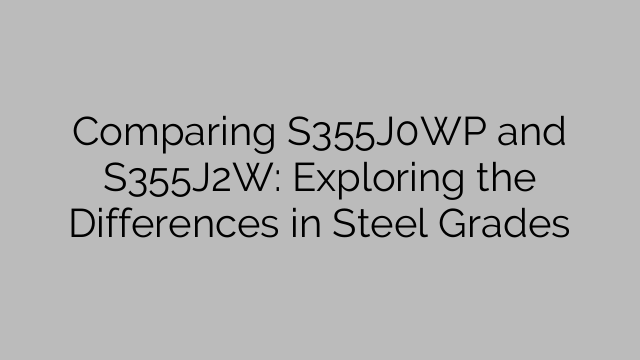Steel is an essential material in various industries, such as construction, automotive, and manufacturing. Two popular and commonly used steel grades are S355J0WP and S355J2W. Although they may appear similar on the surface, there are significant differences between these two steel grades. In this article, we will explore and compare the differences in S355J0WP and S355J2W to help you understand their unique features and applications.
S355J0WP and S355J2W are both weathering steel grades that belong to the EN 10025-5 standard. Weathering steel, also known as corten steel, is a group of steel alloys that have improved atmospheric corrosion resistance compared to regular carbon steel. These steel grades are designed to develop a protective layer of rust when exposed to the atmosphere, which helps to extend the lifespan of the material.
One of the primary differences between S355J0WP and S355J2W lies in their chemical compositions. S355J0WP has a higher phosphorus content than S355J2W, which helps in enhancing its atmospheric corrosion resistance. Additionally, S355J0WP contains a small amount of chromium, copper, and nickel that further contribute to its corrosion resistance properties. On the other hand, S355J2W contains a higher amount of chromium, nickel, and copper compared to S355J0WP, making it even more resistant to atmospheric corrosion.
Another significant difference between these two steel grades is their mechanical properties. S355J0WP has a minimum yield strength of 355 N/mm², while S355J2W has a higher minimum yield strength of 355-510 N/mm². This increase in strength makes S355J2W more suitable for heavy-duty applications that require higher structural integrity.
Furthermore, S355J2W offers better weldability and formability compared to S355J0WP. This enhanced weldability allows for easier fabrication and construction processes, making it a preferred choice for structural components and architectural applications.
In terms of applications, both S355J0WP and S355J2W are commonly used in outdoor structures, such as bridges, buildings, and sculptures. These steel grades provide excellent resistance to atmospheric corrosion, making them ideal for environments with high moisture, salt, or air pollution levels, such as coastal areas or industrial settings.
However, due to the differences in their chemical compositions and mechanical properties, specific considerations should be made when selecting the appropriate steel grade for a particular application. If higher strength and improved weldability are required, S355J2W is the preferred choice. On the other hand, if atmospheric corrosion resistance is a crucial factor, S355J0WP might be a better option.
In conclusion, S355J0WP and S355J2W are two weathering steel grades that offer enhanced corrosion resistance compared to regular carbon steel. While both grades provide excellent protection against atmospheric corrosion, they differ in terms of chemical composition, mechanical properties, and suitability for specific applications. Understanding these differences is essential in selecting the most appropriate steel grade for a particular project, ensuring long-term durability and performance.

